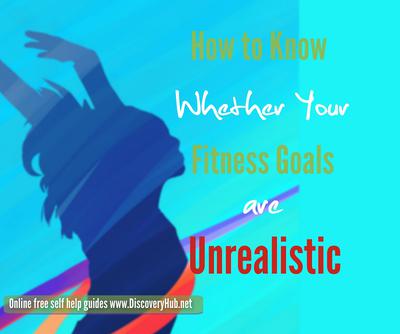How to Know Whether Your Fitness Goals Are Unrealistic
Setting a new fitness goal can be exciting and add a new spark to a dying fitness flame, but sometimes we get too exuberant and overestimate our abilities. We want to challenge ourselves with a new and loftier goal, but sometimes we expect more out of ourselves that we can deliver.
When that happens, it is time to re-evaluate our goal and make it more realistic.
So how do you know if your fitness goal is unrealistic? Usually if any of these three things happen, it is time to scale back and re-adjust:
• You are not making progress toward your goal.
• You are sore beyond expectations.
• Your desire to workout is waning or you have stopped exercising altogether.
Let’s look at each one of these in more detail.
Not making progress
If you have been sticking to your workout and eating schedule, but still not making acceptable progress toward your goal, it is time to look at your program to see what changes need to be made.
What you do depends on your goal. For example, if you want to lose weight, then the calories you eat must be less than the number of calories you burn. Aim for a 500-calorie per day deficit.
Doing so should result in about a 1-pound weight loss per week. But first, you must know how many calories you are eating and how many you’re burning.
Read nutritional labels or search online for calorie-per-serving numbers. Calculate your AMR or Active Metabolic Rate to figure out how many calories you are burning per day based on your metabolism and workout schedule.
This give you an idea of where you need to make changes.
Sore beyond expectations
When first starting a new workout, expect some soreness to set in around 24 to 48 hours after first exercising. The soreness should be mildly irritating.
However, if you are too sore to get up off the couch or must walk down a flight of stairs sideways, it is a good indication you need to change your routine to something less demanding for now and gradually work up to the level of exercise you first set as your goal.
Rome wasn’t built in a day, nor should you expect to reach a lofty fitness goal the first time out of the chute. Set up a progressive schedule and slowly work your way up to where you want to be.
Waning desire
If you no longer have the excitement you first had when you started working out, it could be you need a change in your end goal or the road to get you there.
Perhaps your goal now seems too far away and unreachable. Or maybe you need some variety in your workout. Look at your goal.
If it is still measurable, attainable and realistic, then set up milestones or “mini-goals” along the way that once reached, can be celebrated. Each smaller goal accomplished gets you closer to your end goal.
If you suffer from any of the three unrealistic goal indicators, look to change whatever it is that is holding you back. Success can be right around the corner, if you want it bad enough.
Exercise After 50- What You Should Be Doing
Many people get exercise wrong the older they get. Why? Because they often stop altogether. This is one of the worst things you can do to your body, especially at a time when exercise is needed more than ever.
The aging process hastens breakdown of muscle and connective tissue, and leave you immobile if you sit there and do nothing about it.
Already over 50? No problem, you can still take matters into hand now and prevent an unfortunate outcome. Read on to discover what exercises you should be incorporating into your fitness plan.
Aerobics
Aerobics, also known as cardio or cardiovascular exercise, is important at any point of life, but even more so as we get older.
Aerobic exercise plays an important part in maintaining the health of various organ systems, including the heart, lungs and brain.
Though there are many different types of aerobic exercise, it is best to start with a low-impact variety, to safeguard the safety of the joints until it is established that you can handle more.
Be sure to include the following types of aerobics:
• Swimming
• Cycling (including stationary bikes)
• Walking
• Jogging
Strength Training
Far too many people associate strength training with becoming a bodybuilder or some other strong man type of athlete, but in reality your body needs resistance to stay functional.
People that weight train regularly, especially older persons, have a greatly decreased risk of fractures, pain, and immobility due to muscle atrophy.
You need to perform at least basic strength training, which entails using your bodyweight. Added resistance is good, but do it only when you feel you are capable.
Be sure to include the following movements into your regime:
• Squats
• Bench presses
• Push ups
• Pull up/ assisted pull ups
• Lat pull downs shoulder presses
• Deadlifts / hyperextensions
• Triceps presses
• Dumbbell curls
If you have preexisting joint issues, you can substitute one exercise with another. For example, removing the squat and using leg extensions instead.
Flexibility Training
The single most underrated aspect of any training program has got to be the flexibility component.
The reasons are simple enough to understand, after all, you don’t see any immediate benefit to doing it, so why should you? But there’s another way to look at flexibility training- as insurance.
Think of flexibility training as the insurance that safeguards you in the eventuality of the worst outcome, in this case immobility or injury. Flexibility training has numerous benefits on a body aged over 50, such as:
• Decreases Pain Following Training- part of the reason muscles and joints ache after a workout is because of an inability of muscles to elongate back, or when they do they place undue stress on connective tissue.
• Promotes Balance- loss of balance occurs frequently as we age, due in large part to loss of muscle mass, but also to stiff connective tissue. Flexibility training can significantly help you maintain balance as you age.
Include these in your flexibility training to reap the benefits:
• Dynamic Stretches- these are stretches performed prior to your workout to get the muscle and connective tissue loose and ready for activity. This significantly helps to reduce the risk of injury during an active workout set.
• Static Stretches- these are stretches performed after working out a muscle group, to relieve muscle tension. Static stretches help stretch the muscle fibers and reduce pain after your workout.
Conclusion
A complete plan should include aspects from each of the exercise types mentioned above, to maintain the integrity of joints, heart and muscles.
Staying mobile will definitely contribute to long term health in the long run.
P.S. Liked this post? Be a sharer and spread the word on FaceBook or Twitter or G+.
And I'd love to hear your views or suggestions too! Just click the Comments link below and tell us your story - Thanks!
Cheers, Helene Malmsio
Related Reading: https://www.discoveryhub.net/depression-exercise-guidelines.html
Comments for How to Know Whether Your Fitness Goals Are Unrealistic
|

"Power Tips" magazine is back!
You Get A Free Complete Self Help Report delivered to your email box every edition, plus you get a free PLR article and other great gifts!
SUBSCRIBE BELOW ... I promise you will want to USE what you learn!
I really want to know what you think of this site, this page, and to hear your tips or suggestions about it.
So please share your story or simply add a Comment in the comment box.
If you feel that the information on this page has been useful to you please give it a Like or share it with your friends - thanks!!
"You are a life Saver!!
I recently discovered this site and I can tell you that my life has not been the same. I now come here EVERYDAY and spend at least 1 hour.
I used to spend that time browsing online fashion and beauty
magazine which just means that I spend more. Now I have replaced that
habit with coming here.
In future I will think about contributing articles as well. Thank you! Thank you!! Thank you!!! and God bless"
Contact Us | About Us | Terms of Use | Privacy Policy | FAQ | Testimonials
Amazon and the Amazon logo are trademarks of Amazon.com, Inc. or its affiliates. As an Amazon Associate I earn from qualifying purchases. Product prices and availability are accurate as of the date/time
indicated and are subject to change. Any price and availability
information displayed on [relevant Amazon Site(s), as applicable] at the
time of purchase will apply to the purchase of this product.



















